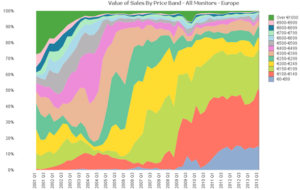We recently heard that there was to be a change at long-established display industry company, Portrait Displays. Founder and CEO, J. Michael James is retiring after more than twenty years and passing control to co-CEOs, Martin Fishman (who will be well known to many DD readers and will be the voice of the company to the world in sales and marketing) and Eric Brumm (Finance, Engineering and IT).
 James told us that while he was dealing with some health issues, he found that his “lieutenants” were running the business, so it was time to take a back seat (he will stay as Chairman).
James told us that while he was dealing with some health issues, he found that his “lieutenants” were running the business, so it was time to take a back seat (he will stay as Chairman).
We decided to take this opportunity to interview James and get his views on his time in the industry.
His first company in the display business was Wyse where he was responsible for the firm’s 15″ and 19″ monochrome (black and white) monitor products which were aimed at those doing a lot of word processing. He then moved to Apple peripheral maker, Radius, which developed a colour “Pivot” monitor, which could switch from portrait mode to landscape mode. James was responsible for bringing the monitor to the PC market. (We found a demo of the monitor on YouTube)
Originally, the monitors were made in Japan, but Radius wanted to change to Taiwan and James was very involved in that. “It wasn’t about design”, he said, “it was about manufacturing”. (Those that weren’t involved in the CRT business will not fully appreciate how sensitive CRT technology was to magnetism. Rotating the CRT involved a lot of re-tuning the display to get acceptable colour performance, as the angle of the fields in the tubes changed with respect to the earth’s magnetic field and caused colours to change! )
Radius got into trouble when Steve Jobs returned to Apple because it had invested heavily in the project to build clones of the Mac, a project that Jobs killed.
So James bought out Pivot business and established Portrait Displays. Manufacturing was still the key, the attention to detail in production was critical and Portrait made T shirts for the staff at the end of the line that did final adjustment.
In CRTs, the analogue technology meant a much wider of range of quality expectations and products. DTP and CAD professionals needed very good displays and there was a big split between the high end and the low end. All the profit and value was in the high end.
This chart from Meko’s DisplayCast service shows how in the CRT days, the market was split between a high end and a low end, but with the arrival of LCD, the high end was squeezed out.
Then came the transition to LCD and that technology moved to Taiwan very quickly. Initially, James said, it was believed that passive LCD was going to win because of the low cost and the difficulty in making TFT LCDs. The form factor of passive LCDs was great, but everything else was bad. However, these were now digital devices – no tuning was really possible in the display after manufacture – after all, a colour filter is fixed. On the other hand, TFT LCDs became the dominant technology for monitors as manufacturing cost tumbled.
Portrait did well with the change to LCD, because of the lighter weight. You could now easily rotate a 15″ LCD much more easily than a 17″ CRTs – and there were no magnetic effects to worry about.
However, “colour quality went way downhill”, James said as LCDs ate up the low end of the market. Colour tuning and performance have become the company’s main skill and, these days, that depends on a deep understanding of the complete display system from software to the CPU through drivers, scalers and TCons.
Notebooks boosted resolution and James told us that at any time, the firm has 100 notebooks and perhaps 200 monitors under test and development. The colour is “typically god-awful”, James told us in notebooks. Panels with just 60% support of NTSC are still common. There are enormous system challenges in notebooks as there is always a battle between display quality and power and the systems are so complex that sometimes even big brands don’t understand fully how all the parts of the display system (including power saving) interact. Sometimes, if you change the power settings, the white point of the display changes.
New solutions to the power issue include RGBW pixels and this is going to introduce new problems. “I can show you a panel that measures as yellow with a colorimeter, but looks green to your eyes”, James told us. (We have an article on RGBW in preparation at the moment – Man. Ed.)
Monitors these days from “good brands” are nearly all sRGB now (Portrait works with companies that represent around 50% of the market) and “phones are fantastic”, with saturated colours that consumers love. However, tablets are at two levels – the branded ones are very good – but the very cheap and “free on contract” models are “awful”.
The saturated colours in some displays, such as OLEDs, are popular, but there can be a “huge difference between accuracy and shelf appeal”.
Looking back over his time of working with brands, James told us that a lot of the job is “managing the trade offs and conflicts”. Different capabilities get set against each other e.g. simple vs accurate. Now the big battle is between display technology and batteries.
There has also been a huge flowering in the range of sizes, shapes and technologies in displays in recent years – with monitor makers “more creative then ever”.
Finally, James told us that he has tried to run the company as a stable partner for its big company clients – it didn’t get caught up in the dotcom boom and bust cycle. He said that after solving problems for ten years or more, you tend to get the first call. (BR)

